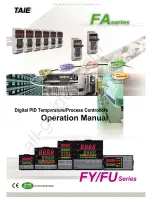
17
LTC1624
10
µ
H inductance is obtained with a current rating of 4A.
Splitting the two windings creates two 10
µ
H inductors
with a current rating of 2A each. Therefore substitute
(2)(10
µ
H) = 20
µ
H for L in the equations.
Specify the maximum inductor current to safely handle
I
L(PEAK)
. Make sure the inductor’s saturation current rat-
ing (current when inductance begins to fall) exceeds the
maximum current rating set by R
SENSE
.
SEPIC Converter: R
SENSE
Selection for Maximum
Output Current
R
SENSE
is chosen based on the required output current.
Remember the LTC1624 current comparator has a maxi-
mum threshold of 160mV/R
SENSE
. The current compara-
tor threshold sets the peak of the inductor current, yielding
a maximum average output current I
OUT(MAX)
equal to
I
L1(PEAK)
less half the peak-to-peak ripple current,
∆
I
L
,
divided by the output-input voltage ratio (see equation for
I
L1(PEAK)
)
.
Allowing a margin for variations in the LTC1624 (without
considering variation in R
SENSE
), assuming 30% ripple
current in the inductor, yields:
R
mV
I
V
V
V
SENSE
OUT MAX
IN MIN
OUT
D
=
+
( )
( )
100
SEPIC Converter: Output Diode
The output diode conducts current only during the switch
off-time. Peak reverse voltage for SEPIC converters is
equal to V
OUT
+ V
IN
. Average forward current in normal
operation is equal to output current. Peak current is:
I
I
V
V
V
I
D PEAK
OUT MAX
OUT
D
IN MIN
L
1
1
( )
( )
( )
=
+
+
+ ∆
Schottky diodes such as MBR130LT3 are recommended.
SEPIC Converter: Input and Output Capacitors
The output capacitor is normally chosen by its effective
series resistance (ESR), because this is what determines
APPLICATIO
N
S I
N
FOR
M
ATIO
N
W
U
U
U
output ripple voltage. The input capacitor needs to be sized
to handle the ripple current safely.
Since the output capacitor’s ESR affects efficiency, use
low ESR capacitors for best performance. SEPIC regula-
tors, like step-down regulators, have a triangular current
waveform but have maximum ripple at V
IN(MAX)
. The input
capacitor ripple current is:
I
I
RIPPLE RMS
L
( )
=
∆
12
The output capacitor ripple current is:
I
I
RIPPLE RMS
OUT
V
V
OUT
IN
( )
=
The output capacitor ripple voltage (RMS) is:
V
OUT(RIPPLE)
= 2(
∆
I
L
)(ESR)
The input capacitor can see a very high surge current when
a battery is suddenly connected, and solid tantalum
capacitors can fail under this condition. Be sure to specify
surge tested capacitors.
SEPIC Converter: Coupling Capacitor (C1)
The coupling capacitor C1 in Figure 7 sees a nearly
rectangular current waveform. During the off-time the
current through C1 is I
OUT
(V
OUT
/V
IN
) while approximately
– I
OUT
flows though C1 during the on-time. This current
waveform creates a triangular ripple voltage on C1:
∆
V
I
kHz C
V
V
V
V
C
OUT
OUT
IN
OUT
D
1
200
1
=
(
)( )
+
+
The maximum voltage on C1 is then:
V
C1(MAX)
= V
IN
+
∆
V
C1
/2 (typically close to V
IN(MAX)
).
The ripple current though C1 is:
I
I
V
V
RIPPLE C
OUT
OUT
IN
1
( )
=
The maximum ripple current occurs at I
OUT(MAX)
and
V
IN(MIN)
. The capacitance of C1 should be large enough so












































